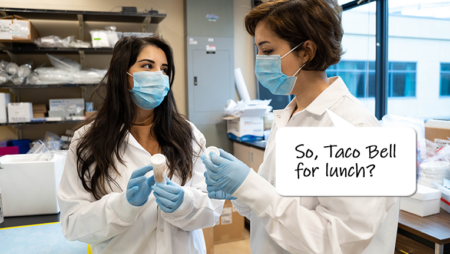Earbud pain killers, lamb chop for dinner, your civets aren’t safe, and more
12 Dec 2020
Posted by Andrew Kantor
The laziness organ
Emory researchers have found the laziness center of the brain. No, they won’t call it that — they call it ‘the part of the brain that weighs the costs versus the benefits of making a physical effort.’
It’s the ventral striatum, and we’ve known for a while that it’s involved in decision making (“whether to pay more for ‘next-day’ delivery or choose ‘free, one-week’ delivery”), but now they’ve shown how it’s also involved in deciding whether to make the effort to get off your caboose: One region weighs the effort vs reward, while another decides if it’s worth “effortful movement.”
It’s more complex than that, of course. Read the article if you want the deets.
Our number two story: Simplifying transplants
Using fecal microbiota transplants works to treat various conditions — C. difficile infections, Crohn’s disease, colitis, and more … but not always. So researchers at the University of British Columbia are trying to develop a way to better match donors and recipients, taking into account not only their genetic profiles, but the specific bacteria each has in their gut.
“Take, for example, blood transplants where we have a strong understanding of the four main blood groups or types, and how they interact with one another. With fecal transplants the research up to this point has not been as clear in what constitutes a good match or compatibility.”
What they’ve found is that there’s enough difference that using a random transplant becomes more of a crap shoot. They hope to develop a formula or system of tests that can be used to increase the likelihood of success.
“The data illustrates that the unique microorganisms in everyone’s bodies respond differently over time, and this has profound implications on whether these transplants work well or not.”

These are, in fact, the actual researchers.
Earbuds vs arthritis
Forget opioids — if you want to deal with the chronic pain of rheumatoid arthritis, just stick these earbuds in your ears*. A company called Nēsos (who I now hate for its hard-to-type name) developed an earbud that, instead of the dulcet sounds of Frank Sinatra or BTS, sends an electrical current through the inner ear.
Rather surprising for someone borrows them without asking.
An electrical current travels through the auricular branch of the vagus nerve and ultimately targets a pathway in the brain that controls inflammation.
It doesn’t work as well as existing drugs, but it also doesn’t have as many side effects.
* Where else would you stick earbuds?
Just you wait, just you wait
If you thought “Everyone who wants a vaccine can get one,” think again. Between not buying enough from Pfizer, to production delays, to a shortage of people to actually give the vaccine … don’t count on this being over anytime soon.
That said, you can help:
Your patients want immunizations… you need to be ready
GPhA is offering “APhA’s Pharmacy-Based Immunization Delivery: A Certificate Program for Pharmacists” FOUR times in 2021:
January 24 (almost full), March 7, September 19, and December 5 at GPhA headquarters in Sandy Springs.

APhA’s Pharmacy-Based Immunization Delivery certificate training program prepares pharmacists with comprehensive knowledge, skills, and resources necessary to provide immunization services to patients across the lifespan.
CLICK HERE for all the details and to register now!
Mary had a little lamb
Like wine? Like cheese? How about lamb? If not, think about developing a taste. Iowa State neuroscientists believe that a diet that includes cheese, wine, and lamb can help prevent cognitive decline.
Cheese is the big cheese (ha! ha?) — it “was shown to be the most protective food against age-related cognitive problems, even late into life.” But a bit of red wine and lamb (instead of other red meat) also helps.
Unless, of course, it’s just that richer (aka healthier) people are more likely to eat wine, cheese, and lamb….

Shari Lewis stayed sharp to the end
Old mice, new tricks
Know any old, weak mice that need a boost? The problem might be a protein called 15-PGDH. Blocking it (say Stanford biologists) “restores mass and strength to the animals’ withered muscles and helps them run longer on a treadmill.” And if you give young mice some 15-PGDH, their muscles atrophy and weaken.
Cool thing: No one has implicated 15-PGDH in aging before. Next up: “studying more about what controls the levels and activity of 15-PGDH during normal aging, and how it might affect the function of other tissues in the body.”
And there are still people who think it’s fake
More people died of Covid-19 in the U.S. in one day than died on 9/11, Pearl Harbor, or D-Day.
More Americans have been killed by Covid-19 this year than were killed in World War I, the Korean War, Vietnam War, Gulf War, Iraq War, and War in Afghanistan — combined.
* 283,555 from Covid-19 vs 215,875 for all those wars.
Thymi to the moon
Next time someone says “I built a treehouse for my kids!” you tell them, “Researchers at the Francis Crick Institute and University College London built a human thymus.”
[T]he scientists rebuilt thymi using stem cells taken from patients who had to have the organ removed during surgery. When transplanted into mice, the bioengineered thymi were able to support the development of mature and functional human T lymphocytes.
Ticks don’t get sick … yet
Ticks are evil little buggers, and you know what’s worse? While they can give us Lyme disease, we can’t smack back because — as UC San Francisco researchers found out — they produce and enzyme that protects them from the bacteria found on human skin.
[T]icks are exquisitely constructed blood-sucking machines, with immune systems specially tailored for this unique lifestyle. Their defense strategies are carried out both inside and outside their bodies, she said, killing even our resident microbes as they feed.
The good news? It’s a single gene (“dae2”) that produces the enzyme. Without it, “ticks are vulnerable to infection with Staphylococcus, one of the most common types of commensal bacteria that essentially cover our skin surface.”
In case you were wondering
Besides humans, ferrets, cats, civets, and dogs are most susceptible to the SARS-CoV-19 virus.
What’s safe? Ducks, rats, mice, pigs, and chickens.


